2012 Edge, Explorer get EcoBoosted
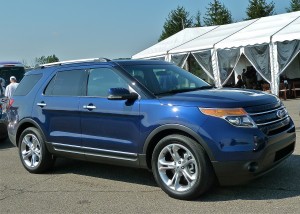
The Explorer, restyled for 2011, adds 240 horsepower and 270 foot-pounds of torque with the EcoBoost 4.
By John Gilbert
DETROIT, MI. — Who could have foreseen that the new and elongated Ford Explorer, and the smaller but roomy crossover Edge, could outperform larger V6 or V8 engines for power as well as at the gas pumps?
Ford Motor Company has unveiled its 2.0-liter 4-cylinder EcoBoost engines for 2012 in both the Explorer and Edge, and driving them shows why Ford is gambling its future on EcoBoost engines. They combine direct injection with turbocharging to produce the power of larger displacement engines with more cylinders, while easily getting significantly better fuel economy than those larger engines.
The power of the EcoBoost V6 has been impressive in the Taurus sedan and the Flex wagon, although its success in V8-traditional F-150 pickup trucks has even surprised Ford executives. Now that the 3.5-liter EcoBoost V6 is outperforming V8s, it’s time to move to Phase 2 and prove that the EcoBoost application to the 4-cylinder can be at least as effective in the Edge and Explorer.
The 4-cylinder in question is one that has been refined numerous times by Ford since first being born at the hand of Mazda’s engine designers in the days when Ford and Mazda cross-swapped engines. Reinforcing the interior componentry of the 2.0-liter 4 to prepare it for more and more sudden bursts of RPMs makes the EcoBoost perform with remarkable power. It develops 240 horsepower and 270 foot-pounds of torque — impressive numbers, for certain. In the process, Edge delivers 30 miles per gallon for a highway estimate, and the Explorer shows 28.  That reinforces Ford’s announcement that by the 2013 model year, 90 percent of all Ford vehicles will have EcoBoost engines available.
It’s not as though the Edge and Explorer needed a boost, so to speak. Since the U.S. economy has battled to regain momentum from our economic struggles, sport-utility vehicles have regained their own momentum, although the swing has been definite to smaller crossovers from the previous popularity of large, truck-based — and gas-guzzling — SUVs. The Edge is the perfect new-age SUV, and recorded sales records for the month of July, while the Explorer, stretched to house three rows of seats and totally restyled on a car platform instead of the truck base previously used, sold more in July than all of last year.
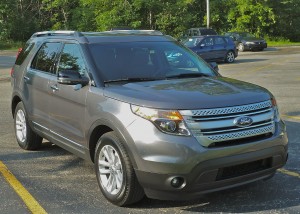
Explorer has been a hot seller, and added power and fuel economy should make the EcoBoost version even hotter.
Amy Marentic, Ford’s group marketing manager, said that Ford’s market research showed 35 percent of Explorer buyers said that fuel economy was the primary reason they chose Explorer. The new Explorer’s 28 EPA highway fuel economy estimate is 40 percent better than its predecessor, the 4.0-liter V6 originally built in Cologne, Germany.
Frank Davis, back from a term working for Ford in Europe, is the new executive director of North American Engineering, and he explained Ford’s basic philosophy that electric vehicles, including hybrids, may well be the future of Ford powerplants, but for right now and the foreseeable future, EcoBoost technology is the best way to improve fuel economy while providing satisfactory power.
It takes power for six cylinders to do the work of eight, and four cylinders to do the work of six, and the turbocharging takes care of the power.
If there was any chance of Ford wavering, the F-150 solidified the theory. Ford officials were concerned that full-size pickup buyers might be reluctant to give up their V8 engines, but when customers realized the EcoBoost V6 had more torque, more pulling power, and could out-drag-race the same vehicle with a V8, they went for the EcoBoost in surprising numbers — 41 percent of all F150s are EcoBoosts, and with price conscious F150 buyers going for the base F150 with the 3.7 V6, for the first time since 1985, V6 pickups are outselling their V8 brethren.
The next step in Ford’s plan to expand the reduced-cylinder/diminished-displacement turbocharged concept was to develop and unveil the 2.0-liter 4-cylinder EcoBoost. Maybe someday that engine will be a major screamer in everything from a Fusion to a Focus or Fiesta, but first it has to become a proven real-world workhorse, and the best way to prove that is in the Explorer and Edge.
Scott Makowski, the powertrain boss, explained the benefits of the EcoBoost technology. First, the 2.0 has been revised so that all the internal parts can handle more and more rapidly achieved RPMs. The engine has direct injection, with the fuel feed pressurized to 2,175 psi before it’s sprayed into each cylinder individually. Tiny oil jets cool the pistons, and the whole system is coordinated by variable valve timing on both intake and exhaust. The exhaust runners are integrated into the cylinder heads for tighter fit.
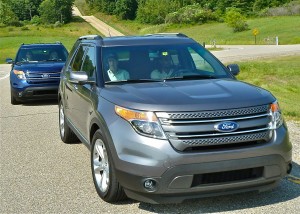
Explorers with their aerodynamic shape are surprisingly potent and fuel-efficient with the 2.0 EcoBoost.
Out on the highways around Ford’s test facility, the Edge proved a willing performer, with quick acceleration and potency that would make an uninformed driver assume there was a V8, or at least a V6, under the hood. In the Explorer, the power is a bit less impressive, but only because the Explorer is a bigger SUV, with a third row of seats and added weight.
On Ford’s test track road course, both vehicles proved their handling capabilities. As swift as they were, they cornered with impressive stability, staying flat and composed no matter how sharp the curves.
I have a couple of criticisms that stubbornly linger, at least until I get an EcoBoost Edge or Explorer for longer road tests. One is the directional signal, which Ford has altered to resemble some European systems.
You switch the stalk to activate the left or right signal, but it doesn’t latch, as they call it. So you let it go and it goes back to its setting. When you turn, the signal cancels itself, but if the turn isn’t sharp enough, and the light keeps blinking, you can cancel it by switching the signal in the same direction again, and it goes off. That, I submit, is counter-intuitive. I find myself almost always trying to switch it the other direction to cancel, only to have the opposite blinker activate. I’ve gotten Ford products to blink several times right, then several left, then more to the right.
Worse, I turn on the directional light, and when I get to an intersection, despite hearing the indicator signal, my fingertip notices the stalk is in its neutral position, so I switch the stalk to re-establish the signal — only to have turned it off in the process. With a couple of different Ford officials riding with me, I made more turns without a proper signal flashing on a 5-mile test run than I’ve made in the past 10 years. Total.
While every Ford official can explain why the company tried such a technique, not one of them can explain any single thing that was wrong with the conventional system. The biggest difference I maintain is that with the old system, I always signal before turning, and with Ford’s new “no-latch†device, I almost never get it right.
My other main complaint is that while a 6-speed automatic is provided to harness the EcoBoost, there is no manual shift-gate or paddles to allow manual gear shift overrides. Ford executives explain that the little switch on the side of the shift knob can be pushed to drop the transmission down a gear. There also, apparently, is a means to push that button more than once to activate further downshifts. Once again, the whole thing is nowhere close to the simplicity or efficiency of a simple manual shift gate, where you can click the lever into the plus-minus mode and either push it forward to upshift or pull it back to downshift.
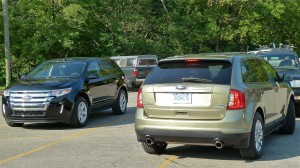
The more compact Edge has gotten a facelift outside, and sporty performance with the EcoBoost addition for 2012.
On these complaints, the EcoBoost versions of the Explorer and Edge are no different from all the new Ford trucks. And when Ford officials suggest I’d probably get used to the new devices if I owned one, and it was my only vehicle, I can almost agree.
The fuel economy of the EcoBoost is understandable. By coaxing the Explorer EPA highway estimate up to 28 miles per gallon, and the Edge to 30 mpg, Ford engineers have accomplished their mission. But if you drive either vehicle hard, that mileage will drop considerably, if our test drives were any indication.
Amy Marentic, in praising the new EcoBoosts, said, “The Edge gets better fuel economy than the Civic Si.â€
I didn’t have the heart to tell her that while the Edge EcoBoost EPA number is 30, and the high-performance but non-turbo Civic Si is 29, I just drove a Civic Si for a week. It delivered an over-EPA 31.5 miles per gallon in combined city-highway driving. Then I took it on one extra-aggressive drive, on my favorite twisty roadway up in the north woods, and to my great surprise, the Si attained 37 miles per gallon on that 75-mile stretch.
That’s one of the problems with EPA ratings. Some vehicles live up to them, some don’t quite reach them, and some actually achieve better. So when a car executive says one vehicle “gets better†fuel economy, they should say it has a higher EPA highway estimate.
Maybe the Edge or Explorer EcoBoost will over-achieve, but it’ll take a week-long test to prove it. Regardless, it will be better than the V6, or the previous V8, even while its power can blow them both away.
Comments
Tell me what you're thinking...
and oh, if you want a pic to show with your comment, go get a gravatar!


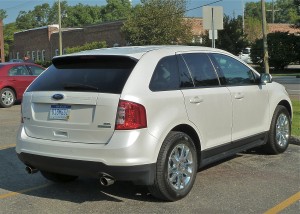
 John Gilbert is a lifetime Minnesotan and career journalist, specializing in cars and sports during and since spending 30 years at the Minneapolis Tribune, now the Star Tribune. More recently, he has continued translating the high-tech world of autos and sharing his passionate insights as a freelance writer/photographer/broadcaster. A member of the prestigious North American Car and Truck of the Year jury since 1993. John can be heard Monday-Friday from 9-11am on 610 KDAL(www.kdal610.com) on the "John Gilbert Show," and writes a column in the Duluth Reader.
John Gilbert is a lifetime Minnesotan and career journalist, specializing in cars and sports during and since spending 30 years at the Minneapolis Tribune, now the Star Tribune. More recently, he has continued translating the high-tech world of autos and sharing his passionate insights as a freelance writer/photographer/broadcaster. A member of the prestigious North American Car and Truck of the Year jury since 1993. John can be heard Monday-Friday from 9-11am on 610 KDAL(www.kdal610.com) on the "John Gilbert Show," and writes a column in the Duluth Reader.